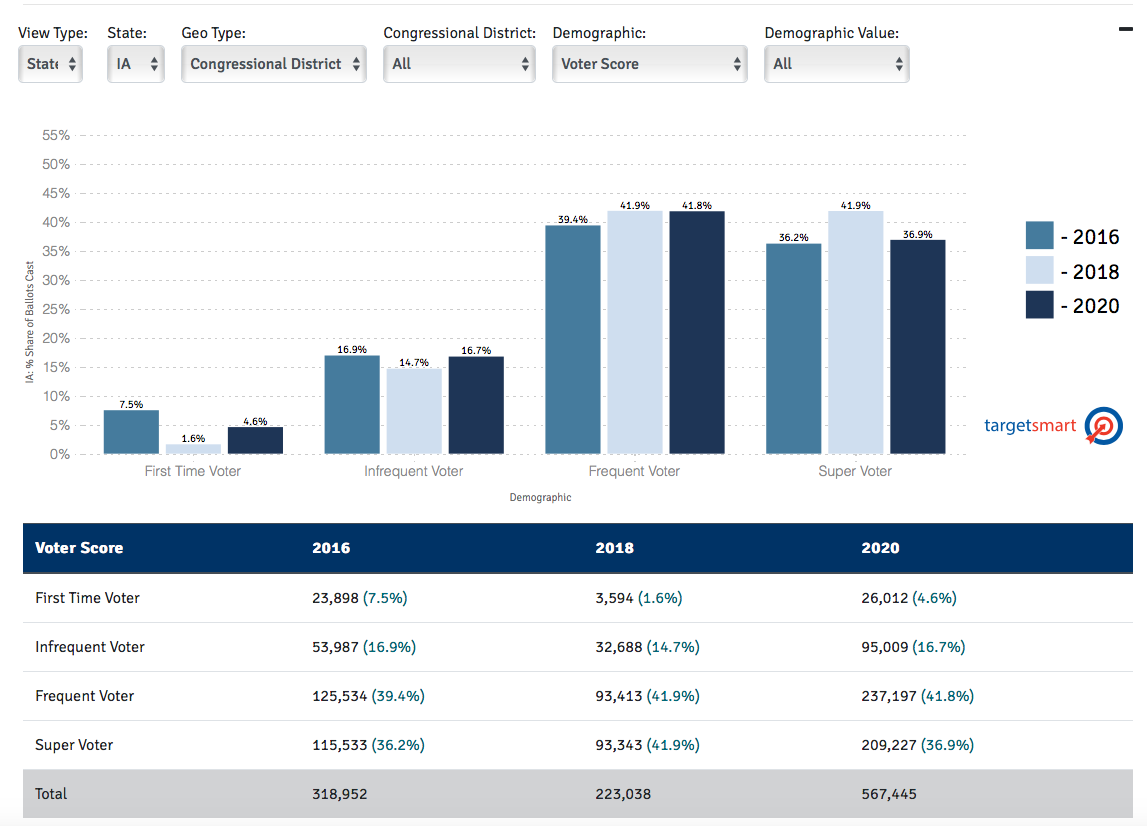Iowans are voting early in larger numbers than ever, due to the COVID-19 pandemic and high levels of interest in the presidential race.
Democrats have good reasons to feel optimistic about the votes banked so far.
1. Democrats have a larger lead over Republicans in absentee ballots cast than in any previous Iowa election.
These are the latest available figures from the Iowa Secretary of State’s office.
| Absentee ballots received by Iowa county auditors as of October 21, 2020 | |||||
| Congressional district | Democrats | Republicans | no-party | other | total |
|---|---|---|---|---|---|
| IA-01 | 88,497 | 43,790 | 28,678 | 536 | 161,501 |
| IA-02 | 87,138 | 42,923 | 27,054 | 509 | 157,624 |
| IA-03 | 87,767 | 45,424 | 25,568 | 661 | 159,420 |
| IA-04 | 56,749 | 52,245 | 20,376 | 411 | 129,781 |
| statewide | 320,151 | 184,382 | 101,676 | 2,117 | 608,326 |
Democrats have cast 135,769 more ballots than have Republicans with nearly two weeks to go.
Two weeks before election day 2016, Democrats led by a little more than 40,000 ballots returned to county auditors, and that gap held fairly steady up to the election. Two weeks before the 2012 election, Iowa Democrats led Republicans in terms of ballots cast by a little more than 56,000, and the lead widened to about 66,500 by election day.
Republicans have limited opportunities to narrow the gap during the next two weeks, because they have requested far fewer ballots than Democrats. As of October 21, 97,319 absentee ballots requested by Democrats had not yet been returned to Iowa county auditors. Republicans had 78,473 absentee ballots outstanding.
In other words, if voters from both parties have comparable return rates, Democrats could slightly expand their lead in votes banked.
2. Democrats are far outpacing their early voting in previous presidential elections.
According to the statewide statistical report from the last general election, 265,603 Iowa Democrats voted early in 2016, about half of the 506,286 Democrats who cast ballots. The report on the 2012 general election shows that 525,624 Democrats voted, of whom 282,655 cast early ballots.
With thirteen days to go, Democrats are already at 120 percent of their 2016 early vote, and at 63 percent of their total 2016 vote. They are at 113 percent of their 2012 early vote and 61 percent of their total 2012 vote.
Meanwhile, of the 576,003 Republicans who voted in the last presidential election, 224,562 cast early ballots. State data indicate that 546,729 Republicans voted in 2012, of whom 216,741 voted before election day.
That means Republicans currently are at 82 percent of their 2016 early vote and at 32 percent of their total 2016 vote. They are at 85 percent of their 2012 early vote and just under 34 percent of their total 2012 vote.
Election day turnout does typically favor the GOP, but that’s a lot of ground for Republicans to make up on November 3.
3. Most independents who will cast a ballot this year have not done so yet.
Iowans affiliated with neither party have been less likely to vote early in past elections than have Democrats or Republicans, and that pattern is holding this year. In 2016, only 157,048 of the 481,770 no-party voters who cast ballots voted before election day. Similarly, 497,496 independents participated in the 2012 general election, of whom 178,837 voted early.
The current number of absentee ballots returned by no-party voters is just below 65 percent of the early vote from 2016 and at 21 percent of the total 2016 vote for that group. It is roughly 57 percent of the early vote by independents in 2012 and 20 percent of the total vote that year by unaffiliated Iowans.
Iowa’s independents favor Democratic candidates for president and U.S. Senate, according to several recent polls (see here, here, here, and here). So if the bulk of them vote on November 3, Republicans will have a steeper hill to climb to overcome the Democrats’ absentee ballot advantage.
4. Democrats are not merely “cannibalizing” their reliable voters.
Because the COVID-19 pandemic has prompted so many Americans to vote early, some analysts have speculated that early voters don’t represent net gains for Democrats. Rather, they reflect a shift by reliable voters from election day to absentee voting.
That’s not entirely true, according to data from TargetSmart’s TargetEarly 2020 website, led by Democratic political strategist Tom Bonier.
TargetSmart’s analysis of early voting shows that of the Iowans who had cast ballots through October 20, an estimated 16.2 percent (92,003 people) did not vote in the 2016 election.
About 26,012 of those were first-time voters. The rest were infrequent voters.
5. The age breakdown of Iowa’s early votes also looks like good news for Democrats.
Most Iowans who had voted by October 20 were over age 50.
Senior citizens favor Joe Biden over Donald Trump, according to recent Iowa polling. And voters age 65 or over have already cast 273,069 ballots, which is 115 percent of the 236,095 who voted early in 2016 and 67 percent of the total vote from seniors (406,478) in that election. It’s also 126 percent of the 216,502 Iowa seniors who voted early in 2012 and 73 percent of the total over 65 vote (371,309) that year.
Iowa Democrats will be able to focus much of the late GOTV on younger voters, who are less reliable participants. The large early vote makes that task somewhat easier by shrinking the “universe” who need to be contacted on or shortly before November 3.
Traditionally, high turnout scenarios are thought to benefit Democrats. But the best chance for Iowa Republicans now would involve an enormous election day turnout, which could help them overcome their deficit in absentee ballots. The certified results from 2016 show that Trump received 800,983 (50.63 percent) of the 1,581,371 ballots cast in Iowa. He lost the early vote by 331,964 to 270,900, but more than made up for it on election day.
Signs point to greater interest in this year’s presidential election, but we can only guess how many more voters will participate, compared to 2016. Republicans would probably have a better chance with a total vote exceeding 1.7 million, rather than turnout in the 1.6 million range. On the other hand, if independents break for Democratic candidates, even very high turnout probably wouldn’t save Trump or Senator Joni Ernst.
Links to Bleeding Heartland posts with tables showing daily early vote totals:
Iowa absentee ballot numbers in the 2020 general election
Iowa absentee ballot numbers in the 2016 general election
Iowa absentee ballot numbers in the 2012 general election
_______________
Appendix 1: Early vote totals as of October 20, 2020 (two weeks before election day)
| Absentee ballots requested by Iowa voters as of October 20, 2020 | ||||||
| Congressional district | Democrats | Republicans | no-party | other | total | |
|---|---|---|---|---|---|---|
| IA-01 | 108,386 | 58,170 | 41,226 | 811 | 208,593 | |
| IA-02 | 111,131 | 57,737 | 40,488 | 750 | 210,106 | |
| IA-03 | 118,084 | 67,134 | 42,681 | 1,107 | 229,006 | |
| IA-04 | 74,769 | 73,951 | 30,531 | 616 | 179,867 | |
| statewide | 412,370 | 256,992 | 154,926 | 3,284 | 827,572 | |
| Absentee ballots received by Iowa county auditors as of October 20, 2020 | |||||
| Congressional district | Democrats | Republicans | no-party | other | total |
|---|---|---|---|---|---|
| IA-01 | 84,434 | 40,395 | 26,304 | 492 | 151,625 |
| IA-02 | 83,086 | 39,763 | 24,968 | 465 | 148,282 |
| IA-03 | 82,557 | 41,961 | 23,265 | 592 | 148,375 |
| IA-04 | 54,274 | 49,001 | 18,971 | 380 | 122,626 |
| statewide | 304,351 | 171,120 | 93,508 | 1,929 | 570,908 |
Appendix 2: Early vote totals as of October 25, 2016 (two weeks before election day)
| Absentee ballots requested by Iowa voters as of October 25, 2016 | |||||
| Congressional district | Democrats | Republicans | no-party voters | other | total |
|---|---|---|---|---|---|
| IA-01 | 55,030 | 37,110 | 29,497 | 365 | 126,533 |
| IA-02 | 59,500 | 38,297 | 28,353 | 383 | 126,533 |
| IA-03 | 57,357 | 45,154 | 23,709 | 369 | 126,589 |
| IA-04 | 39,335 | 48,215 | 24,393 | 303 | 112,246 |
| statewide | 211,222 | 168,776 | 105,952 | 1,420 | 487,370 |
| Absentee ballots received by Iowa county auditors as of October 25, 2016 | |||||
| Congressional district | Democrats | Republicans | no-party voters | other | total |
|---|---|---|---|---|---|
| IA-01 | 37,473 | 22,894 | 16,920 | 204 | 77,491 |
| IA-02 | 42,061 | 24,599 | 17,231 | 237 | 84,128 |
| IA-03 | 38,659 | 27,500 | 13,446 | 210 | 79,815 |
| IA-04 | 26,497 | 28,602 | 14,283 | 191 | 69,573 |
| statewide | 144,690 | 103,595 | 61,880 | 842 | 311,007 |
Appendix 3: Early vote totals as of October 23, 2012 (two weeks before election day)
Absentee ballots requested by Iowa voters as of October 23, 2012
| Congressional district | Democrats | Republicans | no-party voters |
|---|---|---|---|
| IA-01 | 63,954 | 37,114 | 37,732 |
| IA-02 | 68,665 | 39,134 | 37,189 |
| IA-03 | 62,038 | 45,315 | 29,169 |
| IA-04 | 46,412 | 46,419 | 28,333 |
| statewide | 241,069 | 167,982 | 132,423 |
Absentee ballots received by Iowa county auditors as of October 23, 2012
| Congressional district | Democrats | Republicans | no-party voters |
|---|---|---|---|
| IA-01 | 46,139 | 26,188 | 22,968 |
| IA-02 | 50,713 | 28,285 | 23,489 |
| IA-03 | 44,357 | 31,830 | 17,640 |
| IA-04 | 33,810 | 32,413 | 17,830 |
| statewide | 175,019 | 118,716 | 81,927 |
Top image: Iowans waiting to vote early in person at the Polk County elections office on October 16. Cropped from a photo Polk County Democrats chair Sean Bagniewski posted on Twitter.





1 Comment
GREAT WORK!
A couple of points:
1. I have watched the 2016 and 2018 Florida EV and wrote about it at the time. In both years the early voting date was quite revealing. This means something.
2. Target smart missed VERY badly in 2016 with this sort of analysis in Florida.
3. I would watch the youth vote. Siena today found Biden up 59-36 and this is quite a shift from 2016 when the youth margin collapsed in Iowa. In many way youth turnout is the most variable, and to the extent, youth turnout under 30 looks good it is a good sign.
More to say later….
Dan Guild Wed 21 Oct 8:27 PM